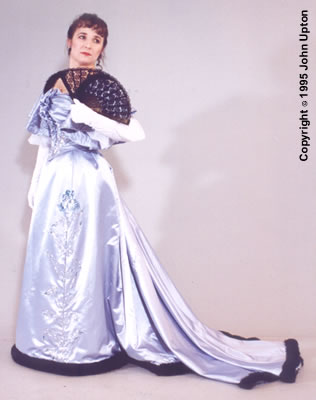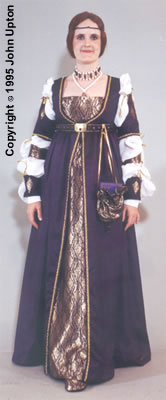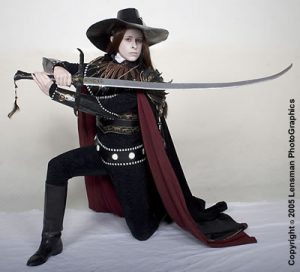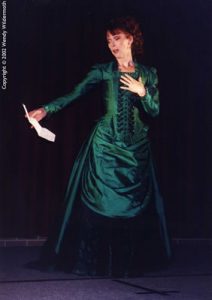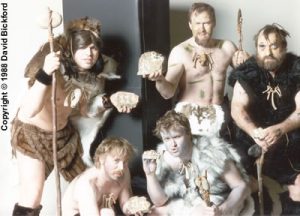CC13-H-04: Italian Renaissance Court Gown
CC13-H-04: Italian Renaissance Court Gown | Division: Novice | Category: Hist. Reproduction | Designer(s): Karen M. Moore | Maker(s): Karen M. Moore | Workmanship Award(s): Karen M. Moore | Presentation Award(s): Best in Class Historical Clothing | Documentation Award(s): Best in Show Documentation (Photo ID: John Upton 95-N25-06 | Event Date: 1995)
Competition Staff & Rules
Staff:
- Directors: Caroline Julian & Janet Naylor
- Master of Ceremonies: Marty Gear‡
- Presentation Judges: Janet Wilson Anderson, Diane Kovalcin, Rob Himmelsbach
Rules:
RULES FOR BOTH MASQUERADES
1. No fire, flash paper, explosions or open flame of any type – No Exceptions. Electronic flashes and or camera flashcubes are permitted in costumes as long as you warn us first so video cameras won’t get burnt out.
2. Purchased or rented costumes may not be shown in competition.
3. Costumes previously worn in the hallways at this convention are ineligible for competition. We will be recognizing hall costumes separately.
4. No mess substances, wet, dry, oily, glitter, talc or other powders, foods, liquids or any other substances that might ruin the costume of any other entrant are to be thrown and or left on stage. If you are doing body paint or make-up, be sure it won’t come off in casual contact with others. Do not leave anything on the stage that a gopher can’t pick up in a few seconds.
5. No live creatures, other than human, will be allowed backstage or on stage. If your costume requires fauna such as snails, ferrets, etc, they must be stuffed or simulated. The exception to this is a seeing-eye or hearing-ear dog needed by an entrant.
6. Each entrant may appear only once on stage. You may enter more than one costume, providing it appears on another body.
7. There will be no live microphones on the stage for contestants. Music and or dialogue must be recorded on audio-cassettes or as typed copy for the MC to read. There will be more information on audio-cassettes in future PR’s.
8. This is a PG-13 rated masquerade; please, no flagrant nudity – No costume is no costume!
9. Costumes with electric power requirements must be self-contained. Connections to electrical outlets will not be available.
10. Surprise the audience, not the masquerade director (or staff), if you are planning something ‘unique’, let us know in advance.
11. The masquerade director(s) have full authority to eliminate anyone from the competition on the basis of taste, danger to the audience or contestants, violation of the above rules, or any other reason deemed sufficient. There will be no appeal. (We haven’t had to use this rule yet, but it’s included for everyone’s safety and peace of mind.)
(Thank you to masquerade directors past and present, from whose rules I have copiously copied! –Jacqueline Ward)
HISTORICAL MASQUERADE
The Historical Masquerade is a favoured tradition at Costume-Con. Unlike the Fantasy and Science Fiction Masquerades, where we are inspired by the realms of imagination and the future, the Historical Masquerade is concerned with the past.
With all history to draw from for ideas, there are really few limits to the type of costume you can create!
The Historical Masquerade will take place at 8 pm Sunday Night. Documentation will be due at Masquerade Registration by 8 pm Friday Night. If you are arriving late, please make alternate arrangements *in advance*. Each contestant will be assigned a particular time slot on either Saturday or Sunday for prejudging. Entry numbers and time slot information will be available at Masquerade Registration by 10 am Saturday.
HISTORICAL CATEGORIES
1) HISTORICAL CLOTHING
Clothing that is intended to look like it comes from a particular period of history. Modern substitutes for period materials are acceptable, so long as knowledge of proper techniques and materials is demonstrated to the judges. (in the past, this category has also been called Historical Reproduction or Recreation.)
2) HISTORICAL COSTUME
A costume that *intentionally* and *visibly* differs from the historical period it is based on. Costumes which combine elements from different cultures or time periods in a way that did not really occur in history belong in this category. (In the past, this category has also been called Historical Interpretation.)
SKILL DIVISIONS
NOVICE
1) A contestant who has won no previous award in any Historical Competition.
2) A first entry in a Historical Competition by a contestant with some experience in another field of costuming.
3) A first entry in any competition.
JOURNEYMAN
1) A contestant who has won at least one *but less than four* major awards at previous CostumeCon Historical Masquerades.
2) A historical costumer with no professional experience and less than four major awards in any historical competitions.
3) An experienced costumer who has won major awards in other fields of costuming but has little or no experience in historical costuming.
MASTER
1) A costuming professional who makes a significant portion of income making or designing historical costumes.
2) A contestant who has won ‘Best in Show’ at a Historical Masquerade at a previous CostumeCon.
3) A contestant who has won four or more major awards for historical costuming at any historical competition.
Any contestant may compete ‘above’ their class should they so wish. Entrants in both the Historical Clothing and Historical
Costume categories will be judged for ‘Best in Show’, but will otherwise not be in competition with each other.
JUDGING
DOCUMENTATION
Documentation is a vital part of historical costuming. Documentation verifies the authenticity of your entry and informs the judges of particularly important aspects of the garment. All documentation should be securely fastened in a binder of some sort and have a title page which includes the title of the costume, the name of the designer and/or maker and a colour photo of you or a model wearing the costume. *DO NOT* submit books! Photocopies are perfectly acceptable. Highlight details you want the judges to particularly consider. Be sure to reference each page in the margin with the name of the book it was taken from. Don’t forget a bibliography of sources. If colour is an important part of your costume, a colour photocopy is good idea. Remember the better organized your documentation is the easier it will be for the judges to read and remember it!
AUTHENTICITY
The entrant may determine the degree to which authenticity is judged. Pre-judging will enable the judges to take a close look at those costumes striving for accuracy and detail. While prejudging is required for all contestants, it can be as brief or as detailed as the entrant wishes.
CREATIVITY
Historical creativity is a delicate balance between period accuracy and inventive design. The garment must be both
consistent to a period of history, and yet original.
WORKMANSHIP
Quality is quality! Whatever the category or skill level, good workmanship deserves recognition. Fit, technical expertise and other details will be judged.
COMPLEXITY
Complexity refers to the scope of the entire project, not just workmanship. Variety of techniques, number of pieces, general difficulty and other intricacies will be considered in the judging.
OVERALL OBSERVATION
Does the entire garment ‘look right’? Do different elements work together to form a harmonious whole?
PRESENTATION
Is the garment worn correctly, with the proper posture and other movements true to the historical period? Does the presentation show off the entry, or limit it? Presentations are particularly popular in the interpretive (Historical Costume) category.
BONUS POINTS
Is there something remarkable or astounding about the entry or the effort that was put into it? Bonus points will not save a mediocre entry but they may break a tie.
TIME LIMITS
Entries with up to 4 individuals will be limited to a maximum of 60 seconds on stage. Entries with 5 or more individuals will be allowed up to 90 minutes on stage. Any group that feels additional time is necessary should discuss it with the Masquerade Directors *before* the convention.
The Costume Con 13 Historical Masquerade Rules and Judging Guidelines are based upon procedures established by previous Costume Cons.
The Following notes contain further details on how Authenticity, Creativity and Documentation (described in Progress Report Two) are scored. Experience historical costumers may find this information to be overly simplified but it is printed here to provide a clearer understanding of the judging process. Historical Masquerade contestants must decide for themselves how closely they wish to conform to the judging criteria.
AUTHENTICITY
An opportunity will be provided during pre-judging for the contestants to have the judges examine details of garments that may not be visible from the stage. Historical Interpretation entrants can decide if they wish to be judged “from the skin out”, and authenticity for both Interpretation and Reproduction entries will only be judged to the degree the contestant wishes. Judging for authenticity will be on a point scale as follows:
0 – Blatantly modern
1 – Period elements incorrectly combined (i.e. inappropriate mix of time and culture. This would not apply to Historical Interpretations such as movie costumes.)
2 – Looks authentic on the surface, but has unauthentic elements in design, color, fabric etc. (“theatre costume” – fake underlayers)
3 – Authentic in look and feel, attempt to reproduce the “hand” of original fabrics and imitate period techniques.
4 – Above, plus a special effort to achieve total period effect, embellishment and accessories made by the entrant,
presented with movement and manners correct for the period.
CREATIVITY
Consideration will be given to originality and consistency to the period. The judges will consider historical creativity on a point scale as follows:
0 – As exact copy from a modern source such as Folkwear patterns.
1 – A standard style for the period mostly copied from a familiar source, like “The Evolution of Fashion”.
2 – Logical combination of period elements, taken from various sources.
3 – Individual interpretation, logical to the period.
4 – Innovative combination of elements, logical to a single period, looks as if it was the work of a single creative historical designer.
DOCUMENTATION
Documentation is an important part of a historical costume. The judges may not be familiar with the details of the garment you have created and documentation plays a significant part in verifying the authenticity of your entry. Documentation must be submitted by 8:00 p.m. on Friday night to allow the judges time to consider it. If you will not be arriving at the convention until after this time on Friday, a copy of your documentation must be sent to the convention so that it is available for the judges by Friday evening.
DOCUMENTATION JUDGING
Documentation will be judged on a point scale as follows:
0 – No documentation or obviously inaccurate.
1 – Minimum information listing time, place and pattern source.
2 – Same as #1, with xeroxes of drawings but no additional detail.
3 – Same as #1, with additional detail including, at the least, specified examples, primary sources if available, and rationale or fabric, color, and design of major elements of garment and construction.
4 – Same as #3, plus rationale for all elements of the costume including the minor details; a display of understanding of general style of the period represented; explanation of any deviations from the period norm.
Please assemble your documentation in the following manner in order for the judges to be able to give it their full consideration:
1) Securely fasten all of your documentation into a binder of some sort.
2) Start with a title page that includes all the following:
A) The Title of the Costume.
B) Your name as the make of the garment.
C) A colour photo of you or your model wearing the garment.
3) DO NOT SUBMIT BOOKS as we cannot be responsible for their safe return and the judges do not have time to look through them. Xerox the pertinent pages and illustrations and use a highlighting, pen to emphasize the things you want the judges to consider. Write the name of the book from which it was copied on the margin of each photocopy. Use color xerox if color is important to your garment.
4) Assemble your documentation in sections and try to limit each section about two typed/printed/or neatly written pages. While you will not be judged on legibility, the easier it is for the judges to read, the better. The sections of your documentation might be as follows:
a) Rationale: why you chose this particular costume, and any historical background on the character that you are portraying.
b) Undergarments: identify and describe the layers.
c) Outergarments:
d) Shoes, hats, jewelry and accessories.
e) Special Skills: if you used any special skills or tools, such as weaving, dying, blacksmithing, shoemaking, etc. Tell the judges about them and provide pictures if appropriate.
5) Please include a “book-list” or bibliography as the last page(s) of your documentation listing all of the sources you used. The quality of your documentation will affect the judges opinion of your entry.
Please take the time to review the above and prepare your documentation accordingly.
TIME LIMITS
Entries with up to 4 individuals will be limited to a maximum of 60 seconds on stage. Entries with 5 or more individuals will be allowed up to 90 seconds on stage. Any group that feels additional time is necessary should discuss it with the Masquerade Director *before* the convention.
[Miscellaneous Notes: This masquerade used the categories Costume and Clothing, which correspond to Historical Interpretation and Historical Reproduction in the photo information.]
